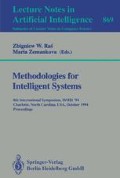Abstract
We apply rough set methods and boolean reasoning for knowledge discovery from decision tables. It is not always possible to extract general laws from experimental data by computing first all reducts [12] of a decision table and next decision rules on the basis of these reducts. We investigate a problem how information about the reduct set changes in a random sampling process of a given decision table could be used to generate these laws. The reducts stable in the process of decision table sampling are called dynamic reducts. Dynamic reducts define the set of attributes called the dynamic core. This is the set of attributes included in all dynamic reducts. The set of decision rules can be computed from the dynamic core or from the best dynamic reducts. We report the results of experiments with different data sets, e.g. market data, medical data, textures and handwritten digits. The results are showing that dynamic reducts can help to extract laws from decision tables.
This work was partially supported by the grant 8S503-019-06 from State Committee for Scientific Research (Komitet Badań Naukowych).
Preview
Unable to display preview. Download preview PDF.
References
Bazan J., Skowron A., Synak P.: Market data analysis: A rough set approach, ICS Research Report 6/94 Warsaw University of Technology 1994.
Brown, E.M.: Boolean reasoning. Dordrecht: Kluwer 1990.
Market data, Hughes Research Laboratories, manuscript.
International Workshop Rough Sets: State of the Art and Perspectives, Poznan — Kiekrz (Poland), September 2–4, 1992. Extended Abstracts. Poznan 1992. Full papers in Foundations of Computing and Decision Sciences, Vol.18, No 3–4 (1993).
Kodratoff Y., Michalski R.(eds.): Machine Learning vol III, Morgan Kaufmann, San Mateo, CA, 1990.
Michalski R., Carbonell J.G., Mitchel T.M. (eds.): Machine Learning vol I, Tioga/Morgan Kaufmann, Los Altos, CA, 1983.
Michalski R., Carbonell J.G., Mitchel T.M. (eds.): Machine Learning vol II, Morgan Kaufmann, Los Altos, CA, 1986.
Michalski R., Tecuci G.: Machine Learning. A Multistrategy Approach vol.IV, Morgan Kaufmann 1994.
Nguyen T., Swiniarski R., Skowron A., Bazan J., Thyagarajan K.: Application of rough sets, neural networks and maximum likelihood for texture classification based on singular value decomposition, submitted for the Workshop RSSC'94, San Jose, California 1994.
Proceedings of the International Workshop on Rough Sets and Knowledge Discovery, RSKD'93, Banff, October 11–15, Canada 1993, 101–104.
Pawlak Z. and Skowron A.: A rough set approach for decision rules generation. ICS Research Report 23/93, Warsaw University of Technology 1993, Proc. of the IJCAI'93 Workshop W12: The Management of Uncertainty in AI, France 1993.
Pawlak Z.: Rough sets: Theoretical aspects of reasoning about data. Dordrecht: Kluwer 1991.
Quinlan J. R.: The Effect of Noise on Concept Learning. In R. S. Michalski, J. G. Carbonell, & T. M. Mitchel (eds.), Machine Learning: An Artificial Intelligence Approach vol.II, Morgan Kaufmann Publishers, San Mateo, California 1986, 149–166.
Quinlan J. R.: Probabilistic Decision Trees. In: Kodratoff Y., Michalski R. (eds.) Machine Learning: An Artificial Intelligence Approach vol. III, Morgan Kaufmann Publishers, San Mateo, California 1990, 140–152.
Quinlan J. R.: C4.5: Programs for Machine Learning, Morgan Kaufmann, San Mateo, California 1993
Raedt De L.: Interactive Theory Revision. An Inductive Logic Programming, Academic Press 1992.
Shavlik J.W., Dietterich T.: Readings in Machine Learning, Morgan Kaufmann 1990.
Shrager, J., Langley, P.: Computational models of scientific discovery and theory formation, Morgan Kaufmann, San Mateo 1990.
Skowron, A. and Rauszer C.: The Discernibility Matrices and Functions in Information Systems. In: R. Slowinski (ed.): Intelligent Decision Support. Handbook of Applications and Advances of the Rough Sets Theory. Dordrecht: Kluwer 1992, 331–362.
Skowron, A.: Boolean reasoning for decision rules generation. Proceedings of the 7-th International Symposium ISMIS'93, Trondheim, Norway 1993, In: J. Komorowski and Z. Ras (eds.): Lecture Notes in Artificial Intelligence, Vol.689, Springer-Verlag 1993, 295–305.
Slowinski, R. (ed.): Intelligent Decision Support. Handbook of Applications and Advances of the Rough Sets Theory, Dordrecht: Kluwer 1992.
Swiniarski R., Nguyen T.: Application of rough sets, neural networks and maximum likelihood for texture classification based on singular value decomposition, Research Report SDSU, San Diego State University 1994.
Tsumoto S.: Medical Data, personal communication.
Trung, Nguyen, Tuan and Son, Nguyen, Hung: An Approach to the Handwriting Digit Recognition Problem Based on Modal Logic, ICS Research Report 44/93, Warsaw University of Technology 1993, M. Sc. Thesis, Warsaw University 1993.
Author information
Authors and Affiliations
Editor information
Rights and permissions
Copyright information
© 1994 Springer-Verlag Berlin Heidelberg
About this paper
Cite this paper
Bazan, J.G., Skowron, A., Synak, P. (1994). Dynamic reducts as a tool for extracting laws from decisions tables. In: Raś, Z.W., Zemankova, M. (eds) Methodologies for Intelligent Systems. ISMIS 1994. Lecture Notes in Computer Science, vol 869. Springer, Berlin, Heidelberg. https://doi.org/10.1007/3-540-58495-1_35
Download citation
DOI: https://doi.org/10.1007/3-540-58495-1_35
Published:
Publisher Name: Springer, Berlin, Heidelberg
Print ISBN: 978-3-540-58495-7
Online ISBN: 978-3-540-49010-4
eBook Packages: Springer Book Archive

